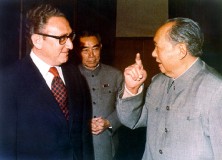The Role of the National Security Adviser and NSC in the Establishment of Relations with the People’s Republic of China — Todd Lorimor

INTRODUCTION:
President Richard M. Nixon’s visit to the People’s Republic of China (P.R.C.) in February 1972 was a precedent-setting milestone in American foreign policy. Since the victory of the Chinese Communist Party over Kuomintang forces in 1949, CCP Chairman Mao Zedong had led the P.R.C. down an increasingly isolated path in the international system. The P.R.C.’s initial foreign policy was to “lean to one side,” supporting the international Communist movement (and thereby the Soviet Union). U.S.-P.R.C. negotiations to “open” China took place behind closed doors, veiled in such secrecy that even relevant government organizations, particularly the State Department, were kept uninformed. This was enabled by the structure of President Nixon’s NSC, which centralized control of foreign policy in the hands of the President and his National Security Adviser, Henry Kissinger.
STRATEGY:
In order to orchestrate diplomatic rapprochement with China, as well as facilitate other policy initiatives, the President and National Security Adviser developed a NSC structure which resulted in a streamlined, parallel flow of information from various NSC member organizations while concentrating decision-making power within the White House. This created an environment in which multiple policy alternatives were presented, and decisions were reached based on criteria that advanced an overall strategy, rather than being rooted in intra- and intergovernmental conflict and compromise.
INTEGRATED ELEMENTS OF NATIONAL POWER:
The structure of the NSC under Nixon was such that the White House set the agenda, and agencies/departments were sometimes given identical tasks, which they completed in isolation. While the administration’s approach to China potentially resulted in duplicated labor, it also provided multiple independent policy perspectives which informed the policy-making process. This NSC structure sacrificed collective decision-making for the sake of decisively implementing long-term strategies.
EVALUATION:
The early implementation of Nixon’s NSC structure resulted in what David Rothkopf refers to as a “devastating bureaucratic first strike,” which defined a clear hierarchy of authority for NSC principals before they had any input on the matter. Nixon and Kissinger had viewed this as necessary in light of expected interagency conflicts, particularly between the Departments of Defense and State. They likewise felt that the State Department was forced to be more reactive than proactive in foreign policy formulation, due to its vast portfolio of responsibilities. This precluded State from engaging in much strategic planning; thus, the National Security Adviser took the lead in mid- to long-range planning. The most important factor in ensuring the effectiveness of the Nixon/Kissinger strategy to open China was the use of “back channel” communications, which eliminated the NSC principals from the decision-making process while still availing of their resources to draft policy briefs and recommendations for top officials. This is likewise the most controversial variable, as it reveals an institutionalized concentration of power in the hands of individual decision-makers. It also created an environment of mutual distrust between the White House and some NSC principals.
RESULTS:
The U.S. government successfully laid the foundations for Sino-American rapprochement. In doing so, it stabilized Northeast Asia, hedged against the Soviet threat, and provided a window for Mao’s successor, Deng Xiaoping, to begin the “reform and opening” of China. However, the Nixon administration also established a precedent for executive secrecy in the conduct of foreign relations, particularly regarding China.
CONCLUSION:
The case of the Sino-American rapprochement illustrates the trade-offs between collective consultation and decision-making in foreign policy, and the need for foreign policy-makers to be proactive and fleet of foot in order to effectively pursue bold initiatives in international affairs. The authors considered in this study are generally in agreement that the national security structures and processes used by Nixon and Kissinger were effective in facilitating successful Sino-American rapprochement. However, there is also a shared skepticism regarding whether or not the approach provides a healthy NSC model for other presidents to follow.